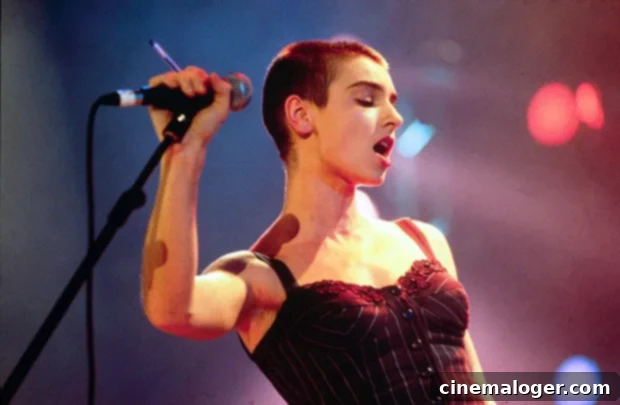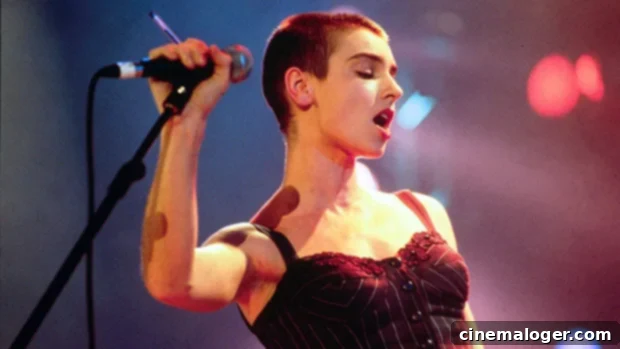Sinead O’Connor: Remembering a Fearless Voice and Unforgettable Legacy at 56
The world of music mourns the profound loss of an icon whose voice transcended genres and whose spirit defied convention. Sinéad O’Connor, the fiercely independent and globally acclaimed Irish singer-songwriter, has passed away at the age of 56. Her death, confirmed on Wednesday, July 26, marks the end of a remarkable life defined by extraordinary artistic talent, unyielding activism, and deeply personal struggles.
O’Connor captivated audiences worldwide with her hauntingly beautiful rendition of Prince’s “Nothing Compares 2 U,” a song that became synonymous with her ethereal vocal range and raw emotional honesty. Beyond the chart-topping hits, she was a brave and outspoken artist, often challenging societal norms and shining a light on difficult truths. Her family released a heartfelt statement, requesting privacy during this incredibly difficult time: “It is with great sadness that we announce the passing of our beloved Sinéad. Her family and friends are devastated and have requested privacy at this very difficult time.”
A Life Marked by Artistry and Heartbreak
Sinéad O’Connor’s life was a tapestry woven with threads of artistic brilliance, controversial stands, and profound personal pain. Her passing comes just over a year and a half after the devastating loss of her beloved son, Shane, who died by suicide at the age of 17 in January 2022. This tragedy profoundly impacted O’Connor, as evidenced by one of her last public messages, a poignant tribute posted on July 17: “Been living as undead night creature since. He was the love of my life, the lamp of my soul. We were one soul in two halves. He was the only person who ever loved me unconditionally. I am lost in the bardo without him.” These words offered a heartbreaking glimpse into the depth of her grief and the unbreakable bond she shared with her son.
Throughout her life, O’Connor was a mother to four children and was married four times. Her journey through motherhood and relationships was often complex but always rooted in deep love. She first married music producer John Reynolds in 1987, and together they welcomed a son, Jake, and a daughter, Roisin, before their divorce in 1991. Her second marriage was to British journalist Nick Monerland in 2001, which concluded in 2004. In the same year, she and musician Donal Lunny welcomed her late son, Shane. In 2006, she gave birth to Yeshua Francis Neil Bonadio, whose father was Frank Bonadio. O’Connor’s third marriage was to Steve Cooney in 2010, which ended in 2011. Later that year, she married Irish therapist Barry Herridge, a union that famously lasted a mere 18 days, though their relationship reportedly remained nebulous for years afterward.
Navigating the Depths of Mental Health Challenges
The year 2022 began with an unimaginable tragedy for Sinéad O’Connor. The body of her 17-year-old son, Shane O’Connor, was discovered on January 7, two days after he was reported missing. In a heart-wrenching public statement, O’Connor tweeted, “My beautiful son, Nevi’im Nesta Ali Shane O’Connor, the very light of my life, decided to end his earthly struggle today and is now with God. May he rest in peace, and may no one follow his example. My baby. I love you so much. Please be at peace.” This profound loss plunged her into a deeper state of distress.

Just a week after Shane’s death, O’Connor herself was admitted to the hospital following a series of alarming Twitter posts that suggested she was contemplating suicide. “I’ve decided to follow my son. There is no point living without him. Everything I touch, I ruin. I only stayed for him. And now he’s gone,” she wrote on an unverified account. Recognizing the severity of her situation, she later updated her followers: “on way to [the] hospital. I’m sorry I upset everyone. I am lost without my kid, and I hate myself. Hospital will help a while. But I’m going to find Shane. This is just a delay.”
Sinéad’s public battle with mental health and self-destructive issues was a lifelong struggle. In 2015, in a now-deleted Facebook post, she claimed she attempted suicide via overdose after a family dispute. “I’m invisible. I don’t matter a shred to anyone. No one has come near me. I’ve died a million times already with the pain of it,” she expressed. She was openly diagnosed with bipolar disorder, post-traumatic stress disorder, and borderline personality disorder. In her 2021 memoir, Rememberings, she bravely detailed how her abusive mother and childhood trauma contributed to her 2015 breakdown. She famously described herself as “a rescue dog,” explaining, “I’m fine until you put me in a situation that even slightly smells like any of the trauma I went through, then I flip my lid. I manage very well because I’ve been taught brilliant skills. There was a lot of therapy. It’s about focusing on the things that bring you peace as opposed to what makes you feel unstable.” Her raw honesty about her struggles made her a reluctant but powerful advocate for mental health awareness.
From Dublin to Global Stardom: The Rise of an Unconventional Icon
Born Sinéad Marie Bernadette O’Connor in Dublin, Ireland, the artist would later adopt the name Shuhada’ Sadaqat after converting to Islam in 2018. Her career ignited with the release of her critically acclaimed debut album, The Lion and the Cobra, in 1987. This powerful introduction earned her a Best Female Rock Vocal Performance nomination at the 1988 Grammy Awards and immediately marked her as an artist unafraid to bare her soul. However, it was her sophomore release, 1990’s I Do Not Want What I Haven’t Got, that catapulted her to international superstardom. The album featured her iconic cover of “Nothing Compares 2 U,” a song originally written by Prince for his side-project, The Family. O’Connor’s intensely emotional, visually minimalist music video for the track, with its single tear rolling down her cheek, resonated deeply with millions. The song soared to No. 1 on the UK Singles chart and dominated the US Billboard Hot 100, making her a household name and solidifying her place in music history.

The Controversial Stand: “Fight the Real Enemy”
While “Nothing Compares 2 U” defined her commercial peak, it was a moment on October 3, 1992, that indelibly etched Sinéad O’Connor into the annals of pop culture history and marked her as an uncompromising activist. Appearing as the musical guest on Saturday Night Live, O’Connor performed an a cappella version of Bob Marley’s “War.” Her performance was not merely a musical act but a powerful, visceral protest against the sexual abuse of children within the Catholic Church and its subsequent cover-up. Towards the end of the song, she held up a photograph of Pope John Paul II, uttered the word “evil,” and dramatically tore the picture into pieces, declaring, “Fight the real enemy.”
This incendiary act ignited a firestorm of controversy, drawing widespread condemnation from various quarters, particularly from Catholics and conservative groups. The immediate fallout was immense, severely impacting her mainstream career in America. While many saw it as an act of sacrilege, years later, as the full scope of the Church’s abuse scandal came to light, many recognized her act as prophetic and courageous, a testament to her unwavering moral compass. Despite the professional repercussions, O’Connor never wavered from her conviction, choosing integrity over popularity, cementing her legacy as a fearless truth-teller.
Later Career and Enduring Influence
The SNL performance undeniably marked a turning point, leading to a career downturn where she never again reached the same level of mainstream American success she had with “Nothing Compares 2 U.” Her latter-day career was often characterized by public controversies and clashes with other celebrities, including Miley Cyrus, Kim Kardashian, and Madonna. Yet, despite the criticism and professional challenges, her indomitable spirit shone through. She continued to create, perform, and speak her mind, defying her detractors and proving that her artistic integrity was paramount.
Her SNL appearance was initially in support of her third album, Am I Not Your Girl?. Over the next two decades, O’Connor continued to record and tour, releasing a consistent stream of music. Her final studio album, 2014’s I’m Not Bossy, I’m The Boss, was her most well-received work in years. Critics praised its vibrant energy and raw honesty. The Guardian hailed it as “ablaze with indignation, lust, and hopelessness,” commending the proclaimed fictional elements of the album as “a triumph of storytelling.” This album demonstrated that even amidst personal turmoil, her artistic flame burned brightly, her lyrical prowess and vocal delivery as compelling as ever.
In November 2020, O’Connor openly announced that she was postponing her 2021 tour to enter a year-long treatment program for trauma and addiction. She shared her journey with her followers, stating, “I had a very traumatic six years, and this year was the end of it, but now recovery starts.” She apologized to her fans for the delays, acknowledging that the music industry “is a very unforgiving place for artists who need to postpone due to emotional or mental health issues.” However, she emphasized that focusing on her health was essential, believing it would ultimately make her a better performer in the future. This decision underscored her commitment to self-care and her characteristic openness about her vulnerabilities.
A Legacy of Unflinching Honesty
Sinéad O’Connor’s passing leaves an irreplaceable void in the music world. She was an artist who dared to be different, to speak truth to power, and to reveal her deepest wounds through her art. Her unique voice, both literal and metaphorical, resonated with millions, offering solace, provoking thought, and challenging the status quo. From her soulful ballads to her defiant protests, O’Connor carved a path for herself that was entirely her own, inspiring countless others to embrace their authentic selves. She was more than just a singer; she was a cultural phenomenon, a warrior, and a deeply sensitive soul whose impact will undoubtedly continue to be felt for generations to come. While her life was marked by sorrow and struggle, her courage and conviction remain an enduring testament to the power of art and the human spirit.
